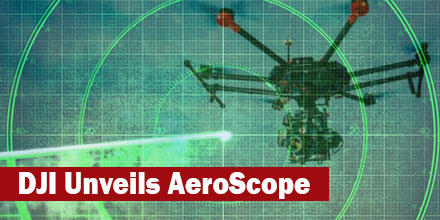AeroScope Technology from DJI to Identify and Track Airborne Drones
 DJI continues to make moves to address the safety and security concerns of operators. There most recent response? The unveiling of AeroScope.
DJI continues to make moves to address the safety and security concerns of operators. There most recent response? The unveiling of AeroScope.
This new product uses existing technology to identify and monitor airborne drones to address safety, security and privacy concerns.
AeroScope uses the communications link between a drone and its remote controller to broadcast identification information. This information includes: a registration or serial number and basic telemetry, including location, altitude, speed, and direction.
New level of accountability?
Police, security agencies, aviation authorities, and additional authorized parties can use an AeroScope receiver to monitor, analyze and act on that information.
Currently, DJI is testing AeroScope at two international airports. In addition to the airports, DJI is testing and evaluating its overall performance in other operational environments.
“As drones have become an everyday tool for professional and personal use, authorities want to be sure they can identify who is flying near sensitive locations or in ways that raise serious concerns,” said Brendan Schulman, DJI’s Vice President for Policy and Legal Affairs. “DJI AeroScope addresses that need for accountability with technology that is simple, reliable and affordable – and is available for deployment now.”
In the beginning of October, DJI demonstrated the system in Brussels, Belgium.
The demonstration showed how an AeroScope receiver can immediately sense a drone as it powers on. AeroScope then plot the drones location on a map and displays its registration number. That number functions as a drone license plate equivalent. In the event a drone raises concerns, authorities can use the registration number to determine the owner.
In March 2017, in response to growing calls by governments worldwide for remote identification solutions, DJI released a white paper describing the benefits of such an approach to electronic identification for drones.
Current functionality
AeroScope works with all current models of DJI drones. Analysts estimate DJI drones comprise over two-thirds of the global civilian drone market.
Since AeroScope transmits on a DJI drone’s existing communications link, it does not require new on-board equipment or modifications. It also does not require extra steps or costs for drone operators.
Other drone manufacturers can easily configure their existing and future drones to transmit identification information in the same way.
AeroScope relies on drones directly broadcasting their information to local receivers; not on transmitting data to an internet-based service. As such, it ensures most drone flights are not automatically recorded in government databases. Thus, protecting the privacy interests of people and businesses that use drones.
This approach also avoids substantial costs and complexities involved in creating such databases and connecting drones to network systems.
DJI’s regulation vs. privacy balance
DJI is an industry leader in developing safety and security advances.
This AeroScope system is consistent with DJI’s problem-solving approach to drone regulation: balancing authorities’ need to identify drones that raise concerns and a drone pilots’ right to fly without pervasive surveillance.
The rapid pace of innovation, DJI believes, provides the best means to address new policy concerns.
The plan is to include drone identification settings in DJI’s initial drone software. Customers can then choose the content of their drone’s identification broadcast to match local expectations.
To protect customers’ privacy, the AeroScope system will not automatically transmit any personally identifiable information until regulations or policies in the pilot’s jurisdiction require it.
“The rapid adoption of drones has created new concerns about safety, security and privacy, but those must be balanced against the incredible benefits that drones have already brought to society,” said Schulman. “Electronic drone identification, thoughtfully implemented, can help solve policy challenges, head off restrictive regulations, and provide accountability without being expensive or intrusive for drone pilots. DJI is proud to develop solutions that can help distribute drone benefits widely while also helping authorities keep the skies safe.”

